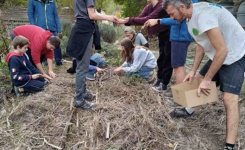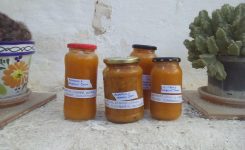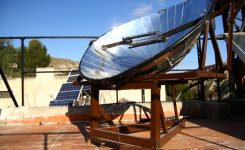Sustainable Living
Sourdough Bread
Our sourdough starter has now been alive for 6 months! Sebastian, our Dutch volunteer who split his time between Organic Gardens and time with fermentation projects with Sustainable Living (and his own), began the starter and we have been experimenting ever since. The last bake was on Sunday with Alder who has a little experience of sourdough although she has experience with regular breadmaking (using instant yeast).
In brief, cultivating a wild yeast for the bread will enable us to have delicious and wholesome bread…without reliance on nipping to the supermarket for yeast. I came to Sunseed with a little experience of using sourdough starters but with an enthusiasm for practising. After all, practise makes permanent! So, I’m still adding a little instant yeast to the recipe (1 tbsp per 25 cups of flour) until I gain more confidence to go fully wild.
Health Benefits
Studies show the fermenting and souring the wheat in bread pre-digests the tough grain and allows it to be much more easily digested by us…even 100% wholewheat, which many people find difficult on the stomach. What’s more, the wild yeasts that fermentation cultivates are reputed to have highly beneficial effects on the health of the beneficial flora in the intestines.
Slow Baking
One obvious reason that sourdough went out of fashion for a while is because the industrialised process of breadmaking is super fast, allowing us to munch on fresh bread within less then a couple of hours of making it. Sourdough bread, on the other hand, even though is much less labour-intensive, requires consistent care over the day. While this is inconvenient if you live alone or have a small working family, for a community like Sunseed who get through more than 25 loaves a week, the whole process if perfect!
Variety
We make 2 types of bread – an 85% rye and a 50/50, which is 50% wholewheat, 50% semi-wholewheat. We avoid white flour for health reasons because it is incredibly energy intensive for industry and any food product that we consume which is devoid of its wholeness robs from the body what it lacks. This can lead to vitamin or mineral deficiencies. So, if we can make a delicious loaf that taste great, lasts a bit longer and also is a tonic for the digestive tract, why would we do anything else?
¡Nuestra masa fermentada lleva viva ya 6 meses! Sebastian, nuestro voluntario holandés que divide su tiempo entre Huertas Orgánicas y Vida Sostenible (y la suya propia) comenzó la masa y hemos estado experimentando desde entonces. La última en hornear el domingo fue Alder: tiene poca experiencia usando masa madre pero tiene experiencia en pan habitual (usando levadura instantánea).
En breve, el cultivo de una levadura silvestre para el pan, nos permitirá tener pan delicioso y saludable… sin depender de visitar el supermercado para la levadura. Vine a Sunseed con un poco de experiencia en el uso masa fermentada y con el objetivo de practicar. Después de todo, ¡siempre estamos practicando! Así, todavía estoy añadiendo un poco de levadura a la receta (1 cucharada por cada 25 tazas de harina) hasta que gane más confianza para ir totalmente salvaje.
Beneficios para la salud
Hay estudios que muestran que la fermentación y agriar el trigo pre-digiere el grano duro y permite que sea digerido más fácilmente por nosotros… incluso usando el 100% de trigo integral, con el que muchas personas encuentran dificultades en el estómago. Es más, las levaduras salvajes tienen fama de tener efectos muy beneficiosos sobre la salud de la flora intestinal.
Horneo lento
Una razón obvia de que la masa madre pasara de moda durante un tiempo, es porque el proceso de elaboración industrial del pan es súper rápido, y nos permite comer pan fresco en menos de un par de horas. El pan de masa fermentada es diferente, a pesar de que requiere menos mano de obra, necesita atención constante a lo largo del día. Si bien esto es un inconveniente si se vive solo o en un grupo pequeño, para una comunidad como Sunseed que usa más de 25 panes en una semana, ¡el proceso es perfecto!
Variedad
Hacemos dos tipos de pan de centeno – uno que es 85% y otro 50/50, que es 50% de trigo integral, 50% semi-integral. Evitamos la harina blanca por motivos de salud y porque requiere mucha energía para ser producida a escala industrial. Por lo tanto, si podemos hacer un delicioso pan que sabe bien, dura un poco más y además es un tónico para el tracto digestivo, ¿por qué vamos a hacer otra cosa?





